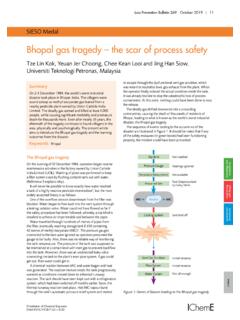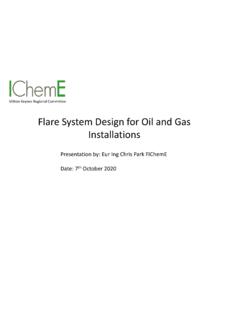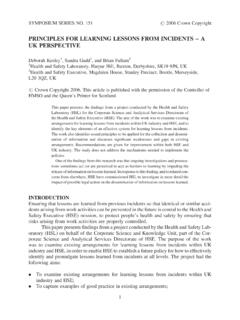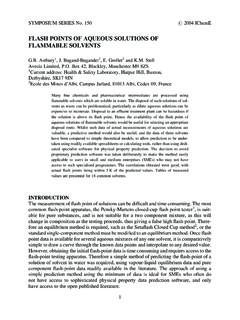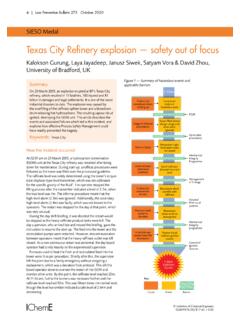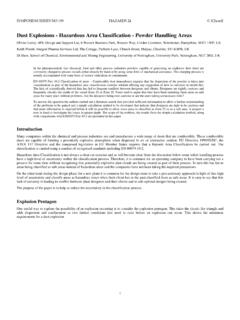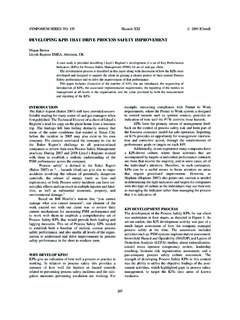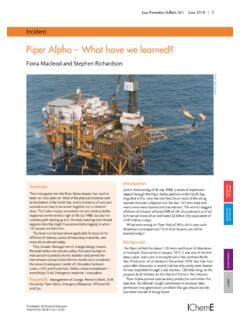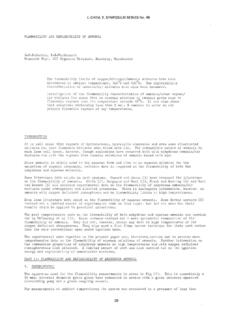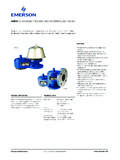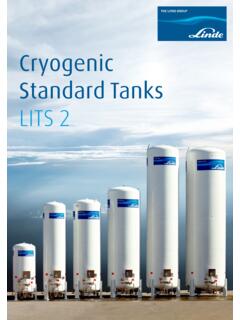Transcription of Pressure relief considerations for low-pressure ...
1 SYMPOSIUM SERIES NO. 151 # 2006 IChemE. Pressure relief considerations FOR LOW- Pressure . (ATMOSPHERIC) STORAGE tanks . Tony Ennis HAZTECH Consultants Ltd. Meridian House Business Centre, Road One, Winsford Industrial Estate, Winsford Cheshire, CW7 3QG, Telephone 44(0)1606 553840, Facsimile 44(0)1606 594144, Many storage tanks currently in use in the chemical and related industries are desig- nated as atmospheric storage vessels. Experience with the design of Pressure relief systems on such vessels has shown that the design and basis of safety for Pressure relief of atmospheric tanks is often misunderstood leading to situations where the tank may be subjected to pressures outside of the design limitations.
2 This paper provides a summary of the design requirements for low- Pressure storage tanks especially relating to the design and sizing of Pressure relief systems. The various Pressure relief cases applicable to storage tanks are considered and the appro- priate sizing calculations discussed in order to provide safe venting of the system. Various types of Pressure relief arrangements are described and their application to differing process conditions and materials is discussed. The key differences between the various types of Pressure relief devices and systems are highlighted in terms of the relevance to the storage of flammable and toxic materials.
3 The design and use of nitro- gen purging and padding and flame arresters on vents is also examined. INTRODUCTION. In this paper, the term tank means atmospheric or low- Pressure storage tank unless otherwise specified. It should be noted that this paper relates to only fixed roof tanks and specifically excludes floating roof construction. Many bulk storage tanks used in the chemical and related industries are described in their documentation as having atmospheric design Pressure . This is something of a mis- nomer because the tank has to operate both above and below atmospheric Pressure to cope with inbreathing and out-breathing flows.
4 Thus, atmospheric storage tanks should prop- erly be described as low- Pressure tanks . Typically this term refers to tanks having design pressures in the range of 56 mbar to 26 mbar although this may be extended to 140. and 210 mbar in some cases. Diagram 1 shows a graphical representation of the various pressures important for low- Pressure tanks . These vessels are very weak in terms of their resistance to Pressure and particularly to vacuum and hence are subject to rigorous design restrictions in terms of their normal breathing requirements and also in terms of emergency Pressure and vacuum relief .
5 Indeed, these vessels may be damaged by under- or over- Pressure situations that could be completely neglected in normal process vessels. 1. SYMPOSIUM SERIES NO. 151 # 2006 IChemE. Many LP tanks have suffered terminal damage due to poor design of venting systems and lack of understanding of design and operational constraints. Damage usually occurs due to under- Pressure rather than over- Pressure because of the extremely limited vacuum resistance of these tanks which, in smaller sizes, may be constructed from plate as thin as 3 4 mm. At best, damage may result in permanent distortion to the tank and at worst in the total destruction of the tank with loss of containment of the contents.
6 This paper is not intended to provide detailed calculation methods as these can be found in the relevant standards which are included as references. This paper is intended to give an overview of the main factors relating to the design of Pressure relief systems fitted to atmospheric and low- Pressure storage tanks . It should be noted that refrigerated storage tanks are outside the scope of this paper due to their more complex nature given space limitations. TYPICAL INCIDENTS. A cone-roof atmospheric storage tank was taken out of service for repairs. As part of the re-commissioning process, the tank was filled up to the overflow level with water in order to check for leaks.
7 The contractor had instructions to drain the tank of water using the 4 . valve located at the base of the tank. In order to speed up the draining process however, the contractor decided to simply remove the 24 access manway at the bottom of the tank completely. The tank venting arrangements were not capable of coping with the flowrate of water through a 24 hole and the tank was destroyed due to the vacuum created. A hot aqueous process stream was wrongly directed to a tank full of cold hydro- carbon. The heat input from the aqueous stream caused rapid vaporisation of the hydro- carbon which then over-pressured the tank and caused a failure of the roof seam.
8 A tank was vented via a lute pot arrangement. The lute pot was originally filled with low viscosity mineral oil but due to a misunderstanding was topped up with water. The water froze in the bottom of the lute thus sealing the main vent line and the tank roof seam ruptured when liquid was pumped in. GENERAL relief DESIGN PHILOSOPHY. A clear understanding of the design philosophy for protection of the tank against over- or under- Pressure is required to ensure safety. Without understanding the basic reasons of how and why the tank must be protected an efficient relief system cannot be designed and installed.
9 It is necessary that all low- Pressure vessels should be protected by a suitable device or combination of devices that will prevent the Pressure from exceeding the maximum design conditions specified. (It may be possible to protect using instrumented protective systems but these are outside the scope of this paper.). At all times, the principles of Inherent Safety should be considered: A Can the source of over- or under- Pressure be eliminated A Can the magnitude of the effects be reduced 2. SYMPOSIUM SERIES NO. 151 # 2006 IChemE. A Can the hazard be contained thus removing the need for a relief system (unlikely for a low- Pressure tank).
10 A Minimise the size of relief system required APPLICABLE STANDARDS & GUIDANCE. There are numerous standards applicable in some way to the design of low- Pressure storage tanks . In terms of the design and fabrication of the tank, BS 2594, BS 2654, API 620 and API 650 are the most commonly used. API 2000 is the most commonly used standard for the calculation of Pressure relief in tanks . API 520 and 521 are aimed more towards Pressure vessels than low- Pressure tanks . Some very limited guidance may be found in Parry although it should be noted that there were some errors in the earliest copies of this work.
